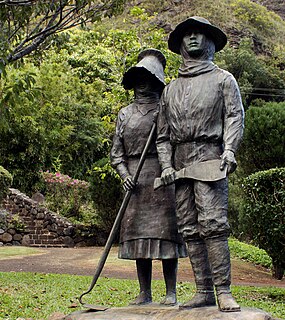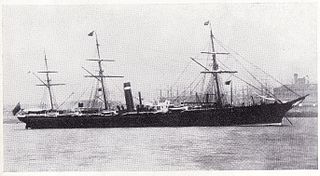
Christopher Condent, born in Plymouth in Devon, was an English pirate who led the return to the Eastern Seas.

The French Frigate Shoals is the largest atoll in the Northwestern Hawaiian Islands. Its name commemorates French explorer Jean-François de La Pérouse, who nearly lost two frigates when attempting to navigate the shoals. It consists of a 20-mile (32 km) long crescent-shaped reef, twelve sandbars, and the 120-foot (37 m) high La Perouse Pinnacle, the only remnant of its volcanic origins. The total land area of the islets is 61.508 acres (24.891 ha). Total coral reef area of the shoals is over 232,000 acres (94,000 ha). Tern Island, with an area of 26.014 acres (10.527 ha), has a landing strip and permanent habitations for a small number of people. It is maintained as a field station in the Hawaiian Islands National Wildlife Refuge by the United States Fish and Wildlife Service. The French Frigate Shoals are about 487 nautical miles northwest of Honolulu.
The Chinese in Hawaiʻi constitute about 4.7% of the state's population, most of whom (75%) are Cantonese people with ancestors from Zhongshan in Guangdong. This number does not include people of mixed Chinese and Hawaiian descent. If all people with Chinese ancestry in Hawaiʻi are included, they form about 1/3 of Hawaii's entire population. As United States citizens, they are a group of Chinese Americans. A minority of this group have Hakka ancestry.

The Japanese in Hawaii are the second largest ethnic group in Hawaii. At their height in 1920, they constituted 43% of Hawaii's population. They now number about 16.7% of the islands' population, according to the 2000 U.S. Census. The U.S. Census categorizes mixed-race individuals separately, so the proportion of people with some Japanese ancestry is likely much larger.

The Portuguese Navy is the naval branch of the Portuguese Armed Forces which, in cooperation and integrated with the other branches of the Portuguese military, is charged with the military defense of Portugal.

The cuisine of Hawaii incorporates five distinct styles of food, reflecting the diverse food history of settlement and immigration in the Hawaiian Islands. In the pre-contact period of Ancient Hawaii, Polynesian voyagers brought plants and animals to the Islands. As Native Hawaiians settled the area, they fished, raised taro for poi, planted coconuts, sugarcane, sweet potatoes and yams, and cooked meat and fish in earth ovens. After first contact in 1778, European and American cuisine arrived along with missionaries and whalers, who introduced their own foods and built large sugarcane plantations. Christian missionaries brought New England cuisine while whalers introduced salted fish which eventually transformed into the side dish lomilomi salmon.
Portuguese Americans (portugueses-americanos), also known as Luso-Americans (luso-americanos), are American citizens and residents of the United States who are connected to the country of Portugal by birth, ancestry or citizenship.

East Indiaman was a general name for any sailing ship operating under charter or licence to any of the East India trading companies of the major European trading powers of the 17th through the 19th centuries. The term is used to refer to vessels belonging to the Austrian, Danish, Dutch, English, French, Portuguese, or Swedish companies.

Blackwall frigate was the colloquial name for a type of three-masted full-rigged ship built between the late 1830s and the mid-1870s.
Korean immigration to Hawaii has been constant since the early 20th century. There have been two distinct points at which immigration has peaked: the first wave from 1903 to 1949, the second wave from 1950 to 1964. On January 13, 2003, George W. Bush made a special proclamation honoring the Centennial of Korean Immigration to the United States, recognizing the contributions of Korean Americans to the nation.

Ravenscrag is the name of several ships, some being sailing vessels and some steamships. One of the sailing vessels is historically significant for bringing to the Hawaiian Islands in 1879 Portuguese immigrants who subsequently introduced the ukulele to island culture.

City of Paris was a British passenger liner operated by the Inman Line that established that a ship driven by a screw could match the speed of the paddlers on the Atlantic crossing. Built by Tod and Macgregor, she served the Inman Line until 1884 when she was converted to a cargo ship.

The PS Hankow was an iron paddle steamer built at A and J Inglis, Pointhouse, Glasgow with Yard No. 107. The Hankow is notable as one of the ships to participate in the 1878 to 1911 wave of Portuguese immigration to Hawaii, when she arrived on 9 July 1883 in Honolulu Harbor with 1,462 immigrants from the Azores and Madeira Island of Portugal to work as contract labor in the Hawaiian sugarcane plantations. She was transferred in 1886 from Yangtze to Hong Kong/Canton service. Gutted by fire on 14 October 1906 at Canton Steamer Wharf, Hong Kong with loss of 130 lives. Towed to Shanghai in 1907 and converted to hulk and moved to Hankow as transhipment godown. Transferred to Shasi in 1930, and to Ichang in 1938. Destroyed by American bombing during WW2.

The Priscilla is a wooden bark that is historically significant for being the first of several ships to bring Portuguese immigrants to the Hawaiian Islands, the Priscilla arriving on 30 September 1878 to Honolulu harbor with 120 settlers recruited from the Madeira Islands of Portugal.
Portuguese immigration to Hawaii began in 1878 when Portuguese residents made up less than 1% of the Island population. However, the migration that began that year of laborers from Madeira and the Azores to work in the sugarcane plantations rapidly increased the Portuguese presence in Hawaii, and by the end of 1911 nearly 16,000 Portuguese immigrants had arrived.

The SV Suffolk is a British sailing ship, built in 1857 as a Blackwall Frigate, that in 1881 became the second ship to deliver Portuguese immigrants from the Azores Islands to Hawaii. It was the fourth ship overall to participate in the Portuguese immigration to Hawaii, having been preceded by the SS Priscilla, SS Ravenscrag and SV Highflyer.

The Earl Dalhousie is a full-rigged sailing ship, built in 1862, that transported British settlers in the 1870s to Australia. It was the fifth ship to participate in the Portuguese immigration to Hawaii when it brought contract laborers in 1882 from the Azores Islands to work on the Hawaiian sugarcane plantations.

Spanish immigration to Hawaii began in 1907 when the Hawaiian government and the Hawaiian Sugar Planters' Association (HSPA) decided to supplement their ongoing importation of Portuguese workers to Hawaii with workers recruited from Spain. Importation of Spanish laborers, along with their families, continued until 1913, at which time more than 9,000 Spanish immigrants had been brought in, most recruited to work primarily on the Hawaiian sugarcane plantations.

SS Orteric is a Clyde-built British cargo ship that on 13 April 1911 brought 960 Spanish and 565 Portuguese immigrants to Hawaii to work on the sugar plantations. The ship was subsequently torpedoed and sunk in the middle of the Mediterranean Sea by a German U-boat during the First World War.

Spanish Americans are Americans whose ancestry originates wholly or partly from Spain.

















